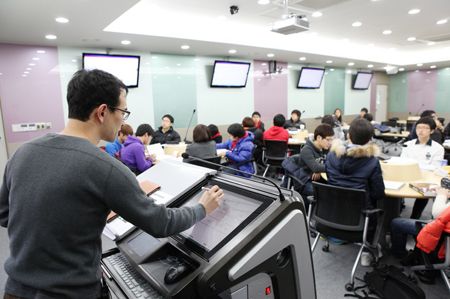KAIST initiates ‘smart education’

A professor teaches with the help of touch-screen monitors at a KAIST lecture hall where the computer uses Education 3.0 software in this file photo. The university implemented Education 3.0, a next-generation educational program, earlier this year to help both teaching and learning. / Courtesy of KAIST
The nation’s most prestigious university in the field of science and technology is adopting a new “smart education” model to incorporate rapidly advancing technology and meet a growing demand from students for better education.
The Korea Advanced Institute of Science and Technology (KAIST) introduced its new program “Education 3.0” early this year. It is structured on two core concepts: utilizing technology and emphasizing student participation, the latter format labeled as I-4.
I-4 is based on the core values of being internationalized, IT-based, individualized and integrated.
It has students studying in groups through discussions and collective problem solving based on lectures provided online. This contrasts with the conventional method of learning based on lectures by professors.
Boosted by positive feedback from students, the school has taken a step further to start the KAIST SYL International Education Initiative (KIEI), which allows international students to participate.
According to KAIST President Suh Nam-pyo, there were several factors that made the school decide to expand the model.
The school first acknowledged the inefficiency of the current method of education at universities, primarily based on lectures delivered by professors to students. High tuition costs had also been a burden to students.
It also had to consider the social changes taking place. The school recognized the need for greater interaction with people around the globe following the advent of globalization.
Moreover, some top educational institutions in the United States decided to share information that was once exclusive. This suggested utilizing this material for self-study at domestic universities, eliminating the need to have professors teach certain classes.
Another point that the school took into consideration was that students currently studying at the school are different to their seniors in that they are more adept at utilizing information technology because they grew up as a generation familiar with the Internet. Perhaps this explains their high satisfaction level with the new education model.
And that is how the school came to expand the model to incorporate a wider range of students.
The KIEI’s purpose is to bring international students to the I-4 programs first initiated among domestic students. Some of these students will be those pursuing a dual degree with KAIST and other partner universities.
The international students recruited for the program will be put into small groups of six with KAIST students. They will interact through the Internet from their home countries.
Exactly the same model as the original I-4 will then be applied. Professors will provide a list of topics the students must learn together each week throughout the semester. The students will audit online lectures recommended by the professor, and collectively solve assigned homework problems.
The students will be interacting online through programs such as Skype. KAIST is considering the application of IT technology that will enable all of the six students in each group to see one another while solving assigned problems, as if they were in the same room. It also has teleconference classrooms in mind.
The essence of I-4 is having students work together to solve problems and discuss the difficulties they encounter while doing the work. Accordingly, homework will also be submitted as one set from the group, instead of individually. The final exam at the end of the term, however, will be taken individually.
KAIST hopes to enhance the learning process, globalize its school and its students, introduce I-4 education globally, and have cyber education take on a greater role. It is also trying to eliminate the traditional boundaries that have isolated educational institutions to effectively utilize human resources for research and intellectual inquiry. <The Korea Times/Kim Bo-eun>
























































